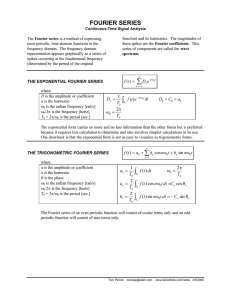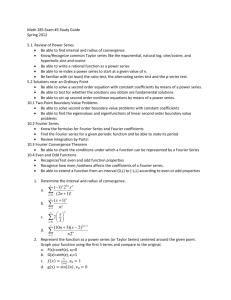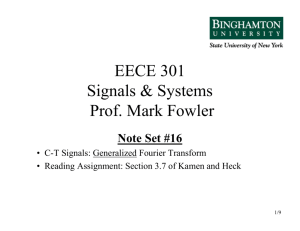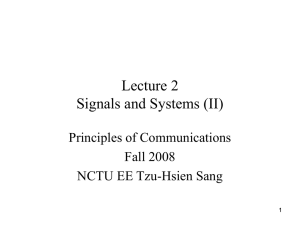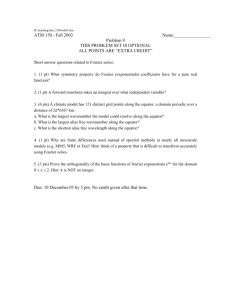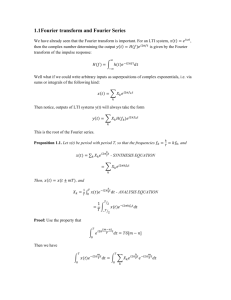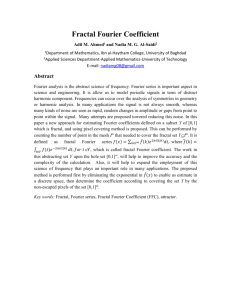ppt - SBEL
advertisement
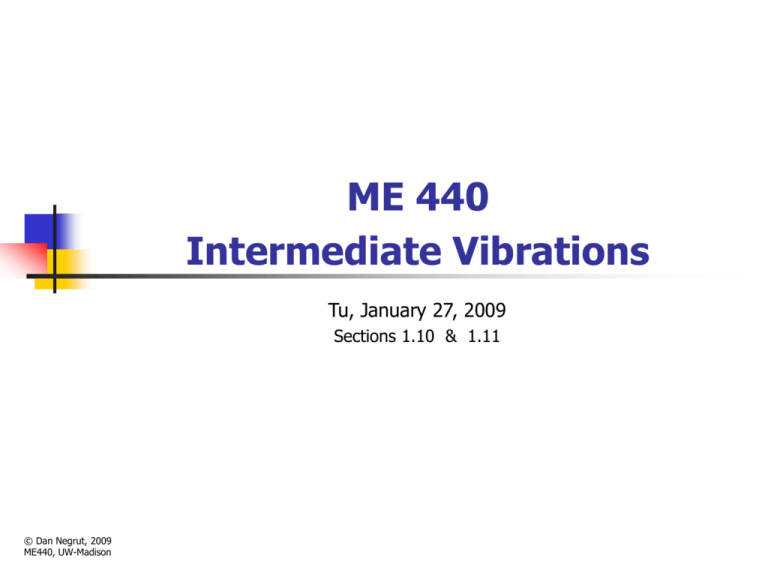
ME 440 Intermediate Vibrations Tu, January 27, 2009 Sections 1.10 & 1.11 © Dan Negrut, 2009 ME440, UW-Madison Before we get started… Last Time: Discussed two examples of how to determine equivalent spring Discussed the concept of linear system and how to linearize a function Covered material out of 1.8, 1.9 Equivalent mass, damping elements Today: HW Assigned: 1.34 and 1.66 out of the text HW due in one week Covering material out of 1.10, maybe start 1.11 Periodic Functions and Fourier Series Expansion 2 General Concepts Periodic Motion: motion that repeats itself after an interval of time is called the period of the function f t Harmonic Motion: a particular form of periodic motion represented by a sine or cosine function Very Important Observation: Periodic functions can be resolved into a series of sine and cosine functions of shorter and shorter periods (more to come, see Fourier series expansion): 3 Sinusoidal Wave The motion with no friction of the system below (mass-spring system) leads to a harmonic oscillation Formally discussed in Chapter 2 Plot below shows time evolution of function Nomenclature: 4 Harmonic Motion (Cntd) If displacement x(t) represented by a harmonic function, same holds true for the velocity and acceleration: Quick remarks: Velocity and acceleration are also harmonic with the same frequency of oscillation, but lead the displacement by /2 and radians, respectively For high frequency oscillation ( large), the kinetic energy, since it depends on , stands to be very large (unless the mass and/or A is very small…) That’s why it’s not likely in engineering apps to see large A associated with large 5 Exercise Show that you can always represent a generic harmonic function as the sum of two other harmonic functions of the same frequency Specifically, for any X and in , find A and B such that Note that in equation above is arbitrary Alternatively, the formula above can be reformulated as (showing only cosine functions on the right side) 6 Review of Complex Algebra The need for complex numbers Solve “characteristic equation” (concept to be introduced later): Roots: To make life simpler, use notation Using notation, roots above become: Incidentally, the following hold: 7 Complex Numbers: From Algebraic Representation to Geometric Representation Representation of complex number z=a+bj provided below Note that Therefore, 8 Dwelling on the Construct (Euler’s Formula) Use Taylor expansion for sine and cosine Sum up and interleave terms to get: In other words, we got Euler’s formula: It follows that our complex number z can be expressed as 9 Algebra of Complex Numbers Multiplication Division Integer powers Roots of order n 10 A Brief Excursion Suppose I have a complex number that changes in time. That is, the real and imaginary part change in time: The first two time derivatives of this function of time are: The important observations are as follows (commutability): This will be used in conjunction with Fourier Series Expansion 11 A Brief Excursion Why is this important? Imagine that you are interested in a quantity the real part of a complex number . which happens to be Then, if you want to find out the value of then simply look at the real part of and the real part of its derivatives: The same general remark holds for the Fourier series expansion 12 (Cntd) If you want to find the Fourier series expansion of then get the Fourier series expansion of . The real part of this expansion is going to be the expansion of . Begin Section 1.11 (Harmonic Analysis) 13 Intro to Fourier Series Joseph Fourier - French mathematician (1768 – 1830) Fourier’s doctoral adviser was Lagrange, whose doctoral adviser was Euler, whose doctoral adviser was Bernoulli, whose adviser was another Bernoulli, whose adviser was Leibniz. The latter had no adviser, he invented Calculus (at the same time as Newton). Fourier’s doctoral students included Dirichlet, who later was the adviser of Kroneker, who later was the adviser of Cantor. 14 Key Result (Fourier) Any periodic function of period can be represented by a series of sin and cosine which are harmonically related Here When is a function f(t) periodic though? A function is periodic if there is a positive, constant, and finite Note: is called the period of the function such that 15 Periodic Functions, Examples 16 Fourier Expansion, Definition 17 Getting Odd, Getting Even A function is odd provided A function is even provided 18 Example 1. Determine the Fourier expansion of the following periodic function: 19

